The Streacom F12C Aluminum Desktop Case Review
by E. Fylladitakis on September 14, 2015 9:00 AM ESTThe Interior of the Streacom F12C Desktop Aluminum Case
Access to the interior of the Streacom F12C is deceptively simple. Two knobs can be seen at the back of the case that look like variable resistors / rheostats. Some might even confuse them for a fan controller. Actually, these knobs are the screws that hold the top panel attached to the body. Rotating them clockwise (they are upside down) will release the top panel. To reinstall it, simply place the top panel back on the case and rotate the knobs counterclockwise.
At first sight, the interior of the F12C chassis appears deviously roomy. That is because the entirety of the case is virtually empty. There are no drive cages or anything else installed inside the case, initially leading to the false suggestion that the F12C is much roomier than it really is.
There are two removable metallic support bars across the center of the case. Unlike with the majority of desktop cases, these are not really meant to enhance the mechanical strength of the chassis. The 4 mm thick aluminum frame of the F12C is exceptionally strong and does not require extra support. Streacom placed the bars there for the installation of cooling fans. The company formally states that these brackets support only two 120 mm fans. However, the truth is that their design and variable mounting points allow for the installation of 80 and 92 mm fans as well. Depending on the height of the motherboard's heatsinks and the location of the first PCI Express card, a liquid cooling radiator up to 240 mm long and 120 mm wide might also fit. Note that the first PCI Express card has to be installed on the second expansion slot for 120 mm fans or a radiator to fit though.
The real innovation with the F12C is the fan and drive mounting system. As mentioned above, there are no cages for HDDs nor mounting points for fans. All that can be found inside the F12C are four metallic bars on either side of the case, attached into a rail using a metallic clip. They can be removed by simply pulling the clip and unlocking it. These bars have holes and rails for the mounting of any 2.5" or 3.5" device or fan up to 120 mm. In fact, the drives can also be installed either vertically or horizontally. Liquid cooling radiators can be installed using these bars as well. Simply attach the bars to the device(s) of your choice, place them back into the rail and lock them with their metallic clips.
For the means of this review, we installed a Corsair AX760i with the red cable set, for strong visual contrast. It fits without issues inside the Streacom F12C and the modular cables help with the limited space. As there are no spaces to hide the cables into, cable management can be messy. However, you should not consider a PSU with too short cables, as they will be unable to reach the left side of the case and the graphics card(s). An ideal solution would be a relatively short and fully modular PSU from a manufacturer that offers short cable kits, allowing the user to use short cables for the devices near the PSU and longer cables for the devices to the left half of the case.
A standard ATX motherboard fits comfortably inside the Streacom F12C, under the assumption that no devices will be attached to the left of the case, below the motherboard. Unfortunately, there is no clearance between the motherboard and the left panel. In theory, this mounting system is a nearly perfect modular solution, allowing the user to have full control over the number and location of the hardware. Inside a small case like the F12C however, there are serious limitations. If a full ATX motherboard is installed, drives or fans installed to the left of the case will block the motherboard's headers or expansion slots. To make sure that nothing on the motherboard is obstructed only one 3.5" or two 2.5" drives fit vertically against the front of the case and, again, the 3.5" drive will limit the length of the graphics card. We feel that the F12C should have been just a little wider, allowing the vertical installation of drives and fans next to an ATX motherboard.
Despite the severe limitations if an ATX motherboard is installed, an ITX motherboard gives plenty of room for the installation of drives across the left side of the case, while a Micro ATX motherboard allows 2.5" drives and cooling fans to be installed without interference. There is also the space in front of the PSU, which is utilizing the same mounting system. With a large PSU such as the Corsair AX760i, there is little room for the installation of drives there, but it is not impossible to fit a couple of 3.5" or up to four 2.5" drives. A short, smaller PSU would open space for more drives or even a 120 mm fan/liquid cooling radiator.


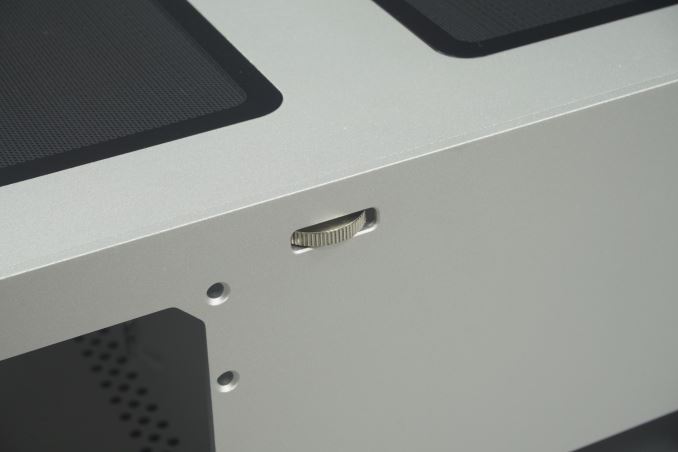
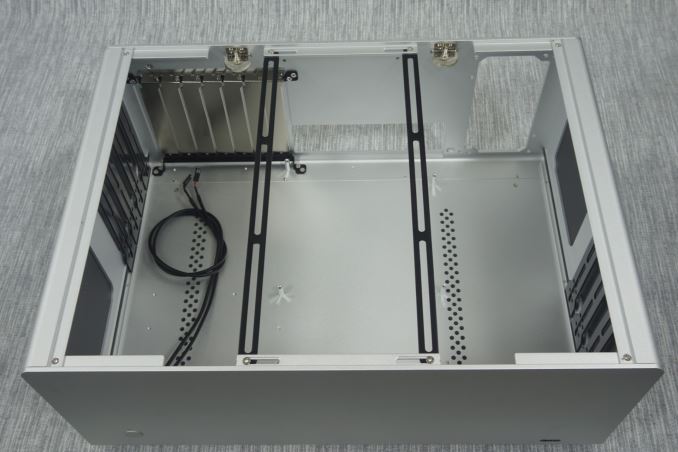
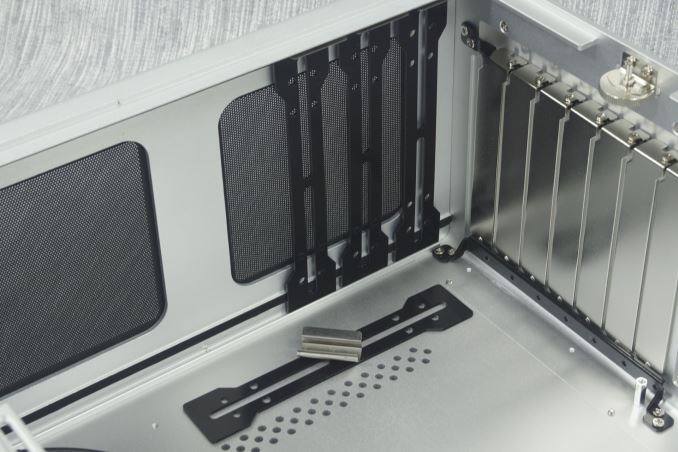
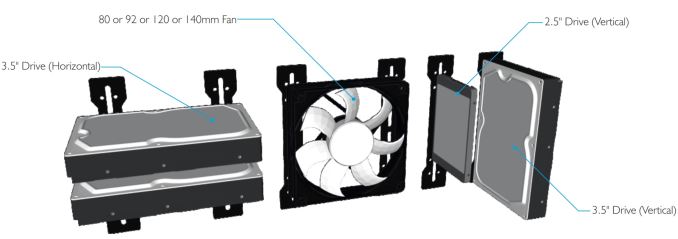
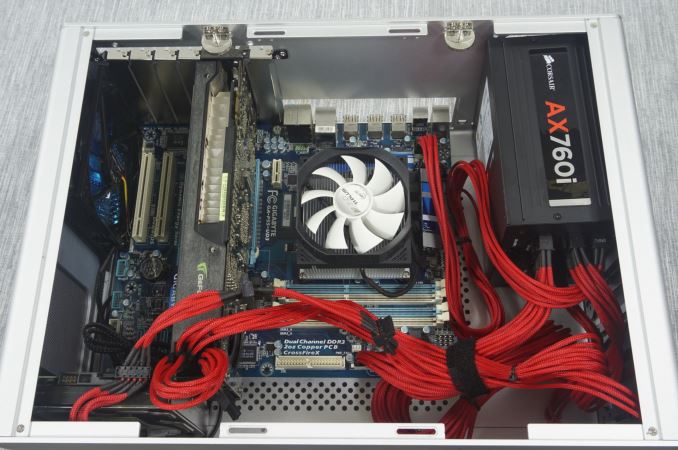
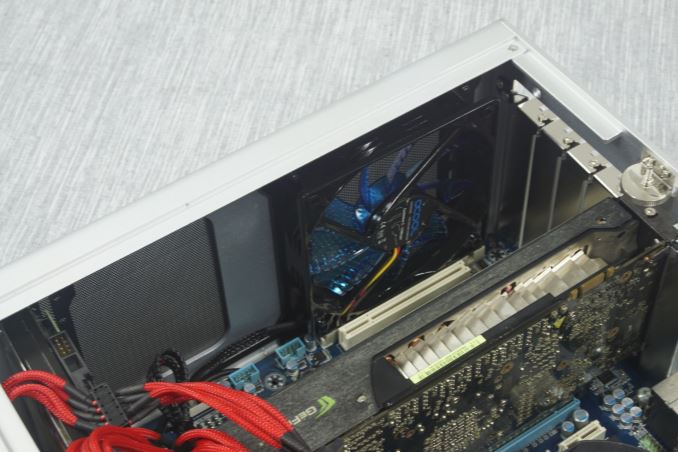
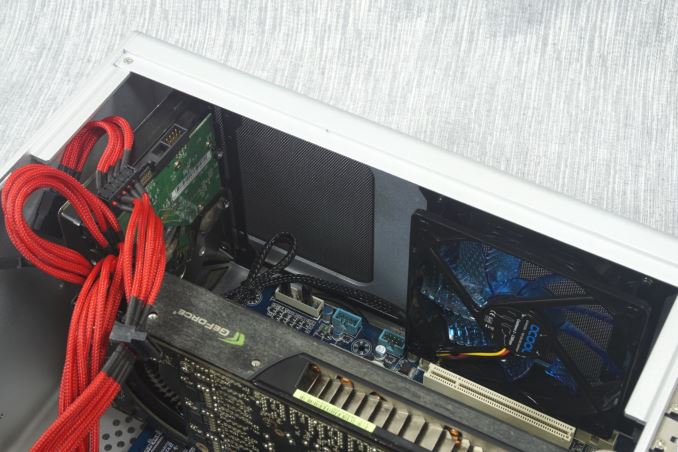








45 Comments
View All Comments
Daniel Egger - Monday, September 14, 2015 - link
I fully agree. I also looked specifically for a case with a 5 1/4" bay and front ports. Found the lovely Lian Li PC-C50B which is not only cheaper and offers the mentioned features but also comes with two fans installed, has plenty of space for drives and is available in black which is kind of important since my receiver and other equipment is also black and a silver case would really look like an alien in my living room... One big drawback of the Lian Li case: You *really* have to love screwing because that's what you'll be doing a lot for any tiny hardware change...Bobs_Your_Uncle - Monday, September 14, 2015 - link
This case isn't for me (at least at the current MSRP) but I really, REALLY like quite a LOT of what I see on display in this case:- tolerances on joints, & especially the external panel seams, etc;
- meticulously precise conical chamfering on external AND internal screw inlets, external AND internal;
- the exceptional proportionate balance of radials (fore & aft) expressed in the 1/2 bullnose treatment that weds to the top panel;
- similar radial expression on right & left side panels flowing into the base.
Extensive photos & well angled views reveal that every element of this case is EXACTLY where they intended & every aspect flows into the next PRECISELY as envisioned. Streacom demonstrates a masterful blending of excellent engineering to gifted design.
I seriously like where they're going in this case. Design choices & asthetics can (& should) be questioned & debated. But like them or not, their execution appears beyond reproach. The disclaimer of course is: photographs. But these photos give rise to the craving for an up close & personal stroll around the block.
As it stands, I'll look into the Lian Li PC-C50B. Cuz I do *REALLY* love screwing but so rarely get the pleasure!
angrypatm - Monday, September 14, 2015 - link
It looks as though it's targeted at Apple people, plain, no ports (no versatility). Its pretty, but not friendly.dwatterworth - Monday, September 14, 2015 - link
Fractal Node 605 makes this thing look just plain silly and overpriced.The major problem with attempting to put any GPU's in these horizontal cases, other than blower-style cooler equipped cards, is the airflow. You can either exhaust or supply, a longer GPU blocks nearly the entire airflow path.
The size I think was more to match existing theater components rather than to provide functionality for this case. It's like they had 2 designers who never talked to each other, one thinking of interior layout and one hacking holes into the exterior. Those top grilles...why not make it more functional and get actual full sized filtered opening with fan mounts? That movable rail system is kind of an afterthought I'd say, little correlation to the case layout or component positioning on the motherboard.
Like the article says, the exclusion of any front USB ports is such a huge omission, people will just end up having a USB extension coming from the back of the case and mucking up what could be a clean appearance in an theater setup. No sound absorption materials with that high ticket price is crazy too. At least some padding above the main CPU and GPU areas. Then to mount some potential mechanical drives right up against the aluminum with no dampeners or anything? Yes, I'd love to conduct all vibrations through the case please!
nightbringer57 - Monday, September 14, 2015 - link
Well thing thing certainly does not look like a big storage champion, to be honest. I'd view it more like a network bound machine for HTPC purposes. Just drop in a SSD for the system, a bigger ssd if you plan on gaming (or a second cheaper/GB SSD)ImSpartacus - Monday, September 14, 2015 - link
Yeah, it's hard to understand the use case for this one.DanNeely - Monday, September 14, 2015 - link
I initially assumed it was a scaled up version of the rest of their cases (presumably checkbox marketing driven design); but while bigger than the remainder of their lineup it has a very different design than the rest.Almost of their gallery shots are of black cases; so I'm not sure why they send this model for review. The rest of their cases are a lot more reasonable too; slim mATX/mITX models that either support half height cards or use a riser to mount a full size card or two parallel to the mobo, and with heatsinks that use heat pipes to connect the CPU to the chassis to use as a giant heat sink. I suspect the one case with the PCIe riser is intended for a pair of full height tv capture/etc cards because a GPU would broil in the case. Some of the cases have room for a small fan; but in their intended mode most look like they would probably function just fine passively cooled. Maybe the fan's for if you're using an HDD; I didn't look that closely at layouts.
The best I can say about this case that it might've been a failed experiment; but the PHBs insisted on production to try and recover some of the r&d costs. It's a pity they decided to send it out for review; almost all of their other cases look like they'd've gotten a better reception.
stephenbrooks - Monday, September 14, 2015 - link
It seems to be a common mistake that "sleek, minimalist design" is assumed to mean "remove all the ports".If the company is really phobic about visible ports they could put a flush door in front of them but TBH in my experience doors are more hassle than they're worth. The USB type-C hole is quite elegant, perhaps we could look forward to a future where you just have a regular array of those on the front of the case...
Morawka - Monday, September 14, 2015 - link
wtf is that a GTX 295 Graphics card you installed in that pc? kinda old and outdated ya thinkBrokenCrayons - Monday, September 14, 2015 - link
I think the point was to illustrate the case layout, cable management, and what a finished system will look like inside the box. Since consistently repeatable testing of case thermal and noise properties uses a specifically designed set of hardware component simulators rather than actual computer parts, the parts used to show layout in the photo aren't as important. Besides that, the size and general shape of dual slot, blower-equipped GPUs hasn't significantly changed in quite a few years so a GTX 295 is perfectly reasonable.